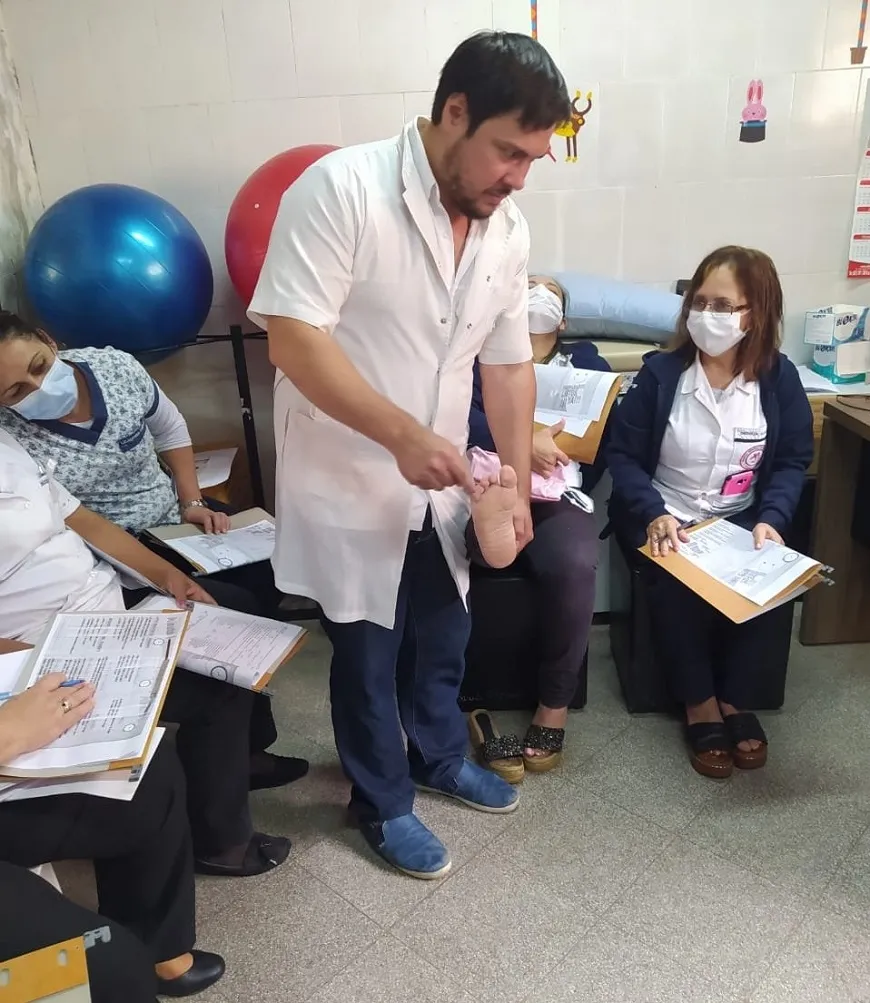In pre -consultation, it is important to dedicate this time to verify background and current status of the patient, perform a vascular, neurological exam, skeletal and dermatological muscle, refer according to risk evaluation and educate.
These and other issues for the integral care of the person with diabetes were addressed in a training aimed at professionals of the General Obrero neighborhood.
Nursing personnel of the Public Health Area of the General Barrio Obrero Hospital participated in training on the care of the feet of diabetes carriers, in order to apply the knowledge acquired in the management of these patients.
Dr. Nelson González, specialized in Diabetology and Endocrinology, trained the team about the value of dedicating three minutes to examine the feet:
• Minute 1: Background and current state of the patient.
• Minute 2: Vascular, neurological examination, skeletal and dermatological muscle.
• Minute 3: Refer according to Risk Evaluation Table and Educate.
Minute 1
Background
Does the patient have diabetes?Since when?How are your monitoring?
Did you present ulcers, amputations or surgeries in lower limbs?
Was Angioplasty, Stent or Bypass placement in lower limbs performed?
Does it present ulcer currently?
Do you smoke?Consume alcohol?
Current state of the patient
Ardor or hormigueros on feet or legs?
Pain or fatigue when walking?
Changes in skin color or injuries in it?
Loss of sensitivity in lower limbs?
Regularly consult the podiatrist to keep the care of his feet?
Minute 2
Vascular examination
Palpar middle pulse and posterior tibial.
Evaluate skin temperature.
Does it have distal hair on your feet?
Evaluate capillary filling time on the fingers of the feet.
Neurological examination
Evaluate loss of protective sensitivity using semi-Westoin monofilament test or fingerboard or Ipswich touch test.
Skeletal muscle exam
Find bone deformities.
Evaluate ankle mobility and first MTF articulation (metatarsophalangeal).
Find pudd signs (hot foot, red, swollen, collapsed arc).
Dermatological examination
Observe the nails, evaluate the presence of nail or interdigital mycosis.
Evaluate calluses, cracks and skin maceration.
Minute 3
Refer.
Evaluate the patient to determine the risk and evaluate follow -up.
Educate.
Inform the patient about the risk of ulceration and amputation.
Remember the patient looking at his feet daily.
Educate the patient about the risks of walking barefoot, even at home.
Recommend the patient about the use of proper footwear.
Advise the patient on the cessation of smoking habit.
Recommend the patient about the proper control of their blood glucose, blood pressure and dyslipidemia.
Educate the patient on how to carry a balanced feeding plan and the importance of performing physical activity and regularly.
How to advise the patient?
Look at your feet every day.If you observe changes in skin color or nails, or note the presence of calluses, cracks, blisters or figures between the fingers, always consult immediately.
Wash your feet with warm water and creamy soap.Dry between the fingers, not let them submerged.
Cut your nails at right angles.File the edges with cardboard lime.
Hydrate the feet with moisturizing cream, without perfume.Do not place it between the fingers.
Always use cotton, white or light -free or elastic socks.
Do not walk barefoot, not even at home.
Do not use flip flops, High Taco Shoes Sandals, espadrilles, canvas shoes.
Do not use hot water bag, electrical pads, heat or other irritating products without medical indication.
It is important to note that most ofThe feet problems faced by diabetic people originates from complications in nerves and blood vessels, which causes poor circulation and lack of sensitivity in lower extremities.It is for this reason that wounds, however small, can become serious infections in a short time.


